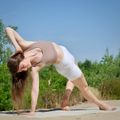Practicing yoga involves more than just physical postures; it's a holistic approach to health and well-being that involves the body, mind, and breath. Breathwork, known as pranayama, is a fundamental aspect of Yoga that harmonizes our vital life force, or "prana."
In yoga philosophy, the breath is considered a bridge between the physical and mental realms. The breath, often seen as a mirror of one's inner state, has the power to influence our thoughts, emotions, and overall state of being. Conscious breathwork allows us to cultivate a deep connection with ourselves, aiding in self-awareness, relaxation, and inner peace.
Incorporating pranayama techniques into your Yoga practice offers several benefits. It may help enhance lung capacity, improve oxygen circulation, and promote relaxation, vital for reducing stress and anxiety. In this blog post, we have a look at the technique of the 3-part breath (Dirga Pranayama), its benefits, and a short guided video so we can practice together.
What is the Three-Part Breath?
Dirga Pranayama, often referred to as the three-part breath, is a cornerstone of Pranayama. It's suitable for all levels, whether you're a beginner or experienced practicioner, and can be done during pregnancy (prenatal and postnatal). It allows you to explore the depths of your breath. By practicing, you can learn to breathe deeper, promote relaxation, and cultivate a heightened state of awareness. Down below, I explain the benefits of the three-part breath in more detail, but let's first see how it's done.
Step-by-Step Guide to Three-Part-Breath:
Prepare
- Begin in a seated position (e.g. easy pose, thunderbolt or on a chair) or in a supine position (Savasana). You can sit on a cushion, Yoga block or folded blanket for support.
- Place one hand onto your belly, just above the navel, and the other hand onto your chest.
- Breathe naturally through your nose, noticing the movement of your body. Continue for 5-10 breath cycles.
- Now, exhale completely to transition into the 3-part breath.
Inhale, Expand, Receive
- Inhale through your nose in one fluid, continuous motion (without pausing): First, breathe into your belly. Then, breathe into your rib cage, noticing the gentle expansion. And finally, move it upwards to fill your chest and feel the expansion of your chest, shoulders and collarbones, leaving your lungs filled with air completely.
Optional: Stay here for a couple of seconds and keep your eyes closed.
Exhale, Release, Let Go
- On your exhalation, release the air in reverse order. First, release the breath from your chest, relaxing your shoulders, neck and collarbone. Moving downwards, release the air from the rib cage, noticing how your upper abdominal muscles contract and finally, release the air from your belly, feeling your entire core engage.
This completes one round of the three-part breath. Repeat for about 6-12 rounds, taking it slow. In short:
Exhale: ⬇️ chest - ribs - belly
Want to give it a try? We can practice the 3-part breath together. Just join me for this 5-minute video:
Benefits of the Three Part Breath
Awareness: The Three Part Breath promotes better awareness. This mindfulness seeps into your asana and meditation practice, amplifying the benefits you receive from them.
Anxiety and Stress: The calming effect of the Three Part Breath can significantly reduce anxiety and stress levels and helps you to feel grounded. With time, you'll become more aware of your breath in everyday life and with that, you can use tools such as the Three Part Breath to feel a sense of calmness, of inner peace.
Nervous System: This style of breathing deeply benefits the nervous system, stimulating both the sympathetic and parasympathetic systems while keeping them calm and controlled which is essential for your mental wellbeing and good health.
Asana and Meditation: Incorporating the Three Part Breath into your yoga routine preps your body for the asana practice at the beginning and readies your mind for meditation and stillness at the end. Its consistent practice brings essential advantages for both the body and mind.
Everyday Life: Learning to breathe fully and completely is really important for our health. Shallow breathing, common in our modern lifestyle, deprives our body of sufficient oxygen, straining our heart and lungs. Deep, complete breathing, as facilitated by this technique, replenishes oxygen levels and helps to reduce stress and anxiety. This practice also cultivates awareness for the present moment and calms the mind.
While breath work is often done during Yoga classes, the three-part breath is easily adaptable to daily life, bringing a grounded and relaxed state of awareness without requiring any special conditions. You can practice this whenever and wherever you need.
Have you tried the three-part breath? Share your thoughts and experiences! How this breathing technique has impacted your Yoga journey? Leave a comment below, and let's connect and learn from each other's experiences 🩵

![Three-Part Breath (with Video) [Dirga Pranayama]](/content/images/size/w1200/2023/11/Three-Part-Breath-Benefits-Tutorial-Breahting-Technique-Dirga-Pranayama-Practice.jpeg)

![15 MIN CANDLELIGHT SLOW FLOW || Moving into Stillness [GYST Retreat #5 – Sun PM]](/content/images/size/w300/2023/08/5_Sun-PM-Moving-into-Stillness.jpeg)
